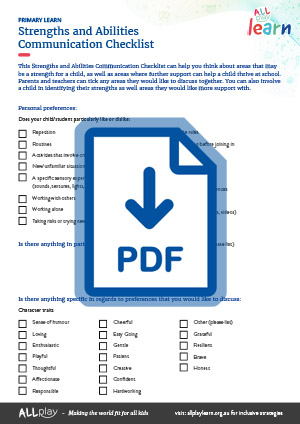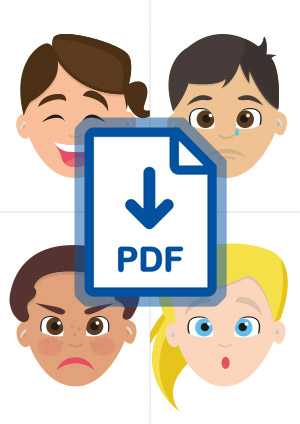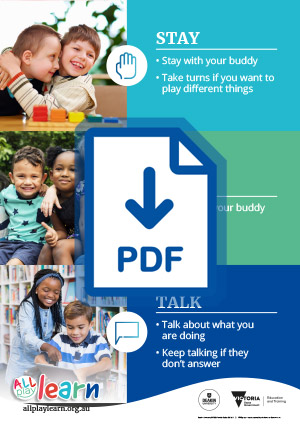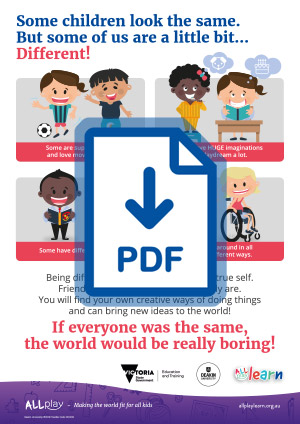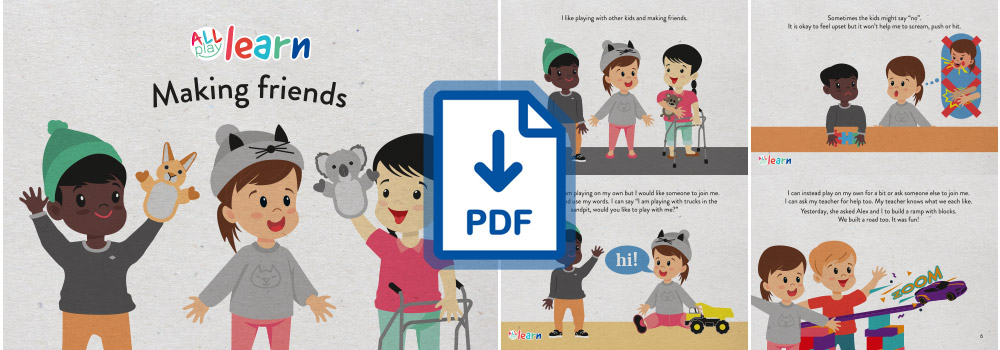
Speech, Language and Communication Needs

About speech, language and communication needs
‘Communication’ is the exchange of both verbal and nonverbal information. It includes talking, as well as understanding words, visual information, body language, facial expressions, and gestures (e.g. pointing, waving hello, nodding your head to mean “yes”).
Young children will vary considerably in the development of their communication skills. Some children will seem to show delays but then ‘catch up’. Individual differences in language ability before the age of around 4 years are not predictive of later outcomes.
Some children may experience difficulty producing sounds and words (e.g. stuttering or mutism), and they may use visual aspects of communication instead (e.g. gestures, eye contact or picture cards). Other children may find understanding the visual parts of communication challenging.
Some children may need support with using and understanding spoken language. A child’s ability to understand spoken language may be different from their ability to use spoken language. For example, a child might be able talk and express themselves clearly, but they may find it harder to understand instructions, especially if they are long or complex.
Some children may also need support with using verbal and nonverbal communication in social situations. For example, some children may have trouble understanding the meaning behind greetings (e.g. saying hello, shaking hands) or taking turns in conversations. Other children may not understand humour and jokes, or metaphors.

Strengths
What might be some strengths?
- Some children may have good visual perceptual skills. They may be good at visual searches and recognition.
- Some children can participate successfully when given clear and specific instructions.
Where might you provide support?
- Some children may have difficulty understanding or giving verbal instructions.
- Some children may have trouble expressing how they feel. This can cause frustration and challenging behaviours.
- Children may need support with interacting with others and building relationships.
- Some children may be easily distracted. They may be unable to focus on learning activities or may have trouble shifting their attention from one activity to another.

Evidence-based strategies
Work collaboratively
Consider how you give instructions and communicate
Create an environment supportive to language development
Provide feedback
- Build a relationship with other professionals involved in supporting the child. Working together can lead to a shared understanding of the child, and consistent strategies across the early childhood education and care setting and other environments like home and the community.
- Set learning and development goals. Consider working with the child’s parents as well as the professionals that support the child (e.g. speech pathologist) to set specific and measurable goals. Aim for goals that focus on the child’s strengths but are also challenging enough to support a child’s learning and social development.
- Give simple, specific and direct instructions. This might allow the child to be a bit clearer about the learning tasks. It can also help to demonstrate/model the task or behaviour, or have another child demonstrate.
- Use different modes of communication. Visual aids, such as picture cards, can be used in addition to verbal instructions to show a task sequence or a key learning concept.
- Provide frequent reminders. Verbal and physical prompts can keep children on track with learning tasks.
- Use slower speech. Use clear and slow speech when talking to children to enhance understanding and the ability to mimic correct speech patterns. Provide explanations of correct pronunciation for mispronounced words and sounds. This helps children learn the correct articulation of speech sounds.
- Model and prompt language use. Use the child’s interests as an opportunity to model and prompt the use of language in day-to-day scenarios and situations. Aim to model words and sentences several times and with a range of visual stimuli. Encourage the child to repeat the sentence or word as needed.
- Pause and expand. Pause to allow children to initiate a topic which is of interest to them. Ask open-ended questions about this topic. Provide children support to construct and expand on responses.
- When reading stories together, promote the child’s interaction. Ask questions while reading, providing children assistance and scaffolding to respond. For example, consider asking children to predict the emotions and actions of characters, or to retell the content of the story. If appropriate, consider playing with toys which match the theme of the book and include the target vocabulary.
- Be responsive. Follow the lead of children, providing responses immediately. If needed, provide feedback. See Provide feedback.
- Singing and storytelling. Singing and storytelling activities can also help children learn new words and improve their language skills.
- Give encouragement immediately after a child speaks. Encouragement can support children’s communication.
- Give corrective feedback promptly. Immediate verbal correction if the child mispronounces words or sentences can help a child learn. Consider repeating what the child has said, with the correct word or sentence structure, in a question format. Take care not to push the child to repeat the correct word or sentence.
- Acknowledge efforts using interests. Acknowledging a child’s efforts may increase their motivation to learn positive social behaviours. Acknowledgement of efforts using the child’s interests may be particularly motivating.

Best practice tips
Get the child’s full attention
Be patient
Encourage positive role-models
Teach meta-cognitive strategies
Teach social skills
Create a responsive environment
Facilitate the use of AAC systems
Promote self-determination
Check you have their attention before giving instructions or speaking to them. This can be done with a gesture, touch, holding eye contact or verbal prompts.
Try not to rush or interrupt a child when they are trying to speak or communicate. Instead, allow extra time for them to speak and respond. Supporting a child with a communication disorder can at times be difficult, and you may feel frustrated. Being aware of your feelings and thoughts is important for a calm and supportive relationship with a child.
Praising other children for positive behaviours (e.g. hands up before speaking, sharing) helps a child to see what is expected. This may encourage them to imitate these behaviours.
- Teach children to use mental imagery. Transforming spoken information into visual images can help reduce the burden on their working memory, and help them understand and remember information better.
- Building the social skills of children can facilitate their communicative participation. For example, you might teach children to consider other people’s feelings, be kind, and share.
- Similarly, teaching children conversational skills, such as asking questions and sharing important information, can facilitate their social interaction with others.
- Arrange the environment to encourage independence and allow children to communicate requests. Respond to all attempts at communication. See Create an environment supportive to language development (be responsive).
- Unaided AAC systems (e.g., signing, vocalisation, facial expressions) and low-tech AAC systems (e.g., picture communication boards and books, visual schedules) can be beneficial in helping children express themselves.
- Make sure that the environment is arranged to facilitate children's communication with these systems. For example, check that the AAC system is placed where children can see and access.
- Add key vocabulary to their AAC system specific to your program (where appropriate). For example, vocabulary related to your schedule, or to a specific learning theme for the week, could be introduced.
- You might also consider additional training on using the relevant AAC systems and collaboration with other professionals and families.
- Promote self-determination. Empower and teach children to make simple choices, set goals, be independent, and develop problem-solving abilities.
- Use technology as needed. For example, technology can be used by children to indicate preference.

Early Years Learning and Development Outcomes
Outcome 1: Children have a strong sense of identity
Outcome 2: Children are connected with and contribute to their world
Outcome 3: Children have a strong sense of wellbeing
Outcome 4: Children are confident and involved learners
Outcome 5: Children are effective communicators
- Educators can help support children’s learning and participation by creating a secure and positive social environment where children can build relationships with educators and other children.
- Educators can help children develop confident self-identities and the ability to interact to others with empathy and respect. Remind children to use social behaviours, and acknowledge their efforts.
- See Teach social skills.
- Role playing and other play-based learning activities may help children with communication needs interact with others and build relationships. Verbal prompts may also be helpful.
- See Create and environment supportive to language development.
- Educators can help support children’s wellbeing by creating a secure and positive social environment where children can build relationships with educators and other children.
- A teaching tip that may be relevant is work collaboratively.
- Reading stories multiple times can help children with communication challenges understand how to pronounce words. It can be helpful to ask the child questions and explaining the meanings of words.
- It can be helpful to combine learning with hands-on activities that are meaningful for the child. For example, read a storybook that focuses on everyday experiences (e.g. brushing your teeth, making friends) and follow it with related role playing or arts and crafts activities.
- Discussing with the child, their family and support team how they communicate and the best ways to use any communication aids can support effective communication.
- Teach other children, educators and professionals to understand and use the child’s communication method. For example, if a child uses pictures and symbols, it might be helpful to include a few of these during play.
- Encouraging children to play with others, especially during free play, may result in spontaneous conversations.
- Consider how you give instructions. Start with simple concepts (e.g. how to pronounce a single letter) and as the child becomes more confident and capable, you can introduce more complex ideas (e.g. making full phrases and sentences).
- Children may need extra support with language and might use pictures, gestures or technology such as tablets and speech devices. Encourage the child to use technology that best supports their play and learning, and that best fits their bodily needs.
- Consider how you give instructions and communicate.

Other considerations
Safety
Behaviour
Toileting
Other educators and early childhood professionals
Transitions
Peer mediation
Other co-occurring conditions
- Some children with communication needs may not know how to tell an adult if there is an emergency, or what to do in an emergency or emergency drill. Consider making time to demonstrate and practise what to do, or provide them with a non-verbal or simple way to communicate an emergency.
- Consider how you give instructions and communicate.
- Stories about social situations can highlight positive behaviours and routines in the early childhood education and care setting.
- Refer to the ABC approach for more information on how to reduce challenging behaviour by supporting the child and promoting more helpful behaviour, and our emotions page for more information about supporting a child with managing their emotions.
- Some children with communication needs may have trouble communicating with an adult about their toileting needs. If this is the case discuss with a child’s family and support team about strategies that can help the child in this area. For example, some basic gestures can be developed for the child to use.
- Consider documenting the strengths and abilities of a child. This can then be provided to other early childhood educators and professionals that may be involved in supporting the child.
- Children may find moving from the early childhood education and care setting to another setting (i.e. another early childhood education and care setting or primary school) challenging.
- For more information about supporting children with disabilities when transitioning to a different education setting, access AllPlay Learn's transition page.
- Speech, language and communication needs can often co-occur with other developmental delays such as autism, and developmental delay. They can also co-occur in children who experience d/Deaf and hard of hearing, or blind or low vision.

Relevant resources
Visit our resources page for a range of resources that can help to create inclusive education environments for children with disabilities and developmental challenges. Some particularly relevant resources include:

